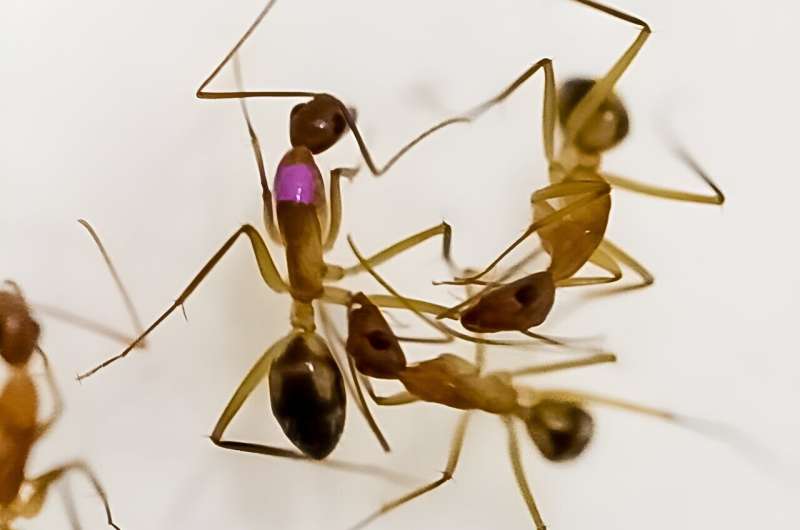This article has been reviewed according to Science X's editorial process and policies. Editors have highlighted the following attributes while ensuring the content's credibility:
fact-checked
peer-reviewed publication
trusted source
proofread
Ants perform amputations to save injured nestmates

Saving lives through surgery is no longer exclusive to humans. In a study published July 2 in the journal Current Biology, scientists detail how Florida carpenter ants, a common, brown species native to its namesake, selectively treat the wounded limbs of fellow nestmates—either by wound cleaning or amputation.
When experimentally testing the effectiveness of these "treatments," not only did they aid in recovery, but the research team found the ants' choice of care catered to the type of injury presented to them.
"When we're talking about amputation behavior, this is literally the only case in which a sophisticated and systematic amputation of an individual by another member of its species occurs in the animal Kingdom," says first author Erik Frank, a behavioral ecologist from the University of Würzburg.
Wound care among ants is not an entirely new phenomenon. In a paper published in 2023, it was discovered that a different group of ants, Megaponera analis, use a special gland to inoculate injuries with antimicrobial compounds meant to quell possible infections. What makes Florida carpenter ants (Camponotus floridanus) stand out is that because they have no such gland, they appear to be using only mechanical means to treat their nestmates.
The researchers found that this mechanical care involves one of two routes. The ants would either perform wound cleaning with just their mouthparts or perform a cleaning followed by the full amputation of the leg. To select which route they take, the ants appear to assess the type of injury to make informed adjustments on how best to treat.
In this study, two types of leg injuries were analyzed, lacerations on the femur and those on the ankle-like tibia. All femur injuries were accompanied by initial cleaning of the cut by a nestmate, followed by a nestmate chewing off the leg entirely. In contrast, tibia injuries only received the mouth cleaning. In both cases, intervention resulted in ants with experimentally infected wounds having a much greater survival rate.
"Femur injuries, where they always amputated the leg, had a success rate around 90% or 95%. And for the tibia, where they did not amputate, it still achieved about the survival rate of 75%," says Frank. This is in contrast to the less than 40% and 15% survival rate for unattended infected femur and tibia abrasions, respectively.
The researchers hypothesized that the preferred path of wound care could be related to the risk of infection from the wound site. Micro-CT scans of the femur showed it is largely composed of muscle tissue, suggesting it plays a functional role of pumping blood, referred to as hemolymph, from the leg into the main body.
With an injury to the femur, the muscles become compromised, reducing their ability to circulate potentially bacteria-laden blood. The tibia, on the other hand, has little muscle tissue and thus little involvement in blood circulation.
"In tibia injuries, the flow of the hemolymph was less impeded, meaning bacteria could enter the body faster. While in femur injuries the speed of the blood circulation in the leg was slowed down," says Frank.
You may expect, then, if tibia damage results in faster infections, amputating the full leg would be most appropriate, but the opposite is observed. It turns out the speed at which the ants can amputate a leg makes a difference.
An ant-assisted amputation takes at least 40 minutes to complete. Experimental testing demonstrated that with tibia injuries, if the leg was not immediately removed post-infection, the ant would not survive.
"Thus, because they are unable to cut the leg sufficiently quickly to prevent the spread of harmful bacteria, ants try to limit the probability of lethal infection by spending more time cleaning the tibia wound," remarks senior author and evolutionary biologist Laurent Keller of the University of Lausanne.
"The fact that the ants are able to diagnose a wound, see if it's infected or sterile, and treat it accordingly over long periods of time by other individuals—the only medical system that can rival that would be the human one," Frank says.
Considering the sophisticated nature of these behaviors, a reasonable next thought would be how these ants are capable of such precise care. "It's really all innate behavior," says Keller. "Ant behaviors change based on the age of an individual, but there is very little evidence of any learning."
Now the lab team is running similar experiments in other Camponotus species to see just how conserved this behavior is and begin to unpack whether all ant species without the special antimicrobial (metapleural) gland also perform amputation. Also, since the ant receiving care allows for the slow removal of a limb while conscious, this calls for further exploration into our understanding of pain in ant societies.
"When you look at the videos where you have the ant presenting the injured leg and letting the other one bite off completely voluntarily, and then present the newly made wound so another one can finish cleaning process—this level of innate cooperation to me is quite striking," says Frank.
More information: Erik Frank et al, Wound-dependent leg amputations to combat infections in an ant society, Current Biology (2024). DOI: 10.1016/j.cub.2024.06.021. www.cell.com/current-biology/f … 0960-9822(24)00805-4
Journal information: Current Biology
Provided by Cell Press


















